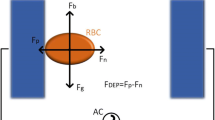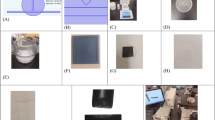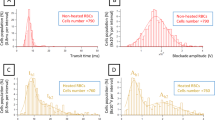Abstract
Red blood cell (RBC) dysfunction is often associated with a pathological intervention, and it has been proposed as a critical risk factor for certain lethal diseases. Examining the cell viability of RBCs under various physiological conditions is essential and of importance for precise diagnosis and drug discovery in the field of medicine and pharmacy. In this paper, we report a new analytical method that employs dielectrophoretic (DEP) force measurements in absolute units to assess the viability, and potentially the functionality of RBCs. We precisely quantify the frequency-dependent DEP forces of the RBCs by using a micro-electrode embedded chip combined with optical tweezers. DEP characteristics are known to be well-correlated with the viability of biological cells, and DEP forces are measured in both fresh and long-term stored RBCs to investigate the effect that the storage period has on the cell viability. Moreover, we investigate the DEP behavior of RBCs when exposed to oxidative stress and verify whether EDTA protects the RBCs from an oxidant. From the experiments, it is found that the fresh RBCs without oxidative stress display very high DEP forces over the entire frequency range, exhibiting two cutoff frequencies. However, both the RBCs stored for the long-term period and exposed to oxidative stress reveals that there exist no significant DEP forces over the frequency range. The results indicate that the DEP forces can serve as a useful parameter to verify whether the RBCs in certain blood are fresh and not exposed to oxidative stress. Therefore, it is believed that our system can be applied to a diagnostic system to monitor the cell viability of the RBCs or other types of cells.



Similar content being viewed by others
References
Apel K, Hirt H. Reactive oxygen species: metabolism, oxidative stress, and signal transduction. Annu Rev Plant Biol. 2004;55:373–99.
Radisky DC, Levy DD, Littlepage LE, Liu H, Nelson CM, Fata JE, et al. Rac1b and reactive oxygen species mediate MMP-3-induced EMT and genomic instability. Nature. 2005;436:123–7.
Finkel T. Signal transduction by reactive oxygen species. J Cell Biol. 2011;194:7–15.
Squier TC. Oxidative stress and protein aggregation during biological aging. Exp Gerontol. 2001;36:1539–50.
Hale JP, Winlove CP, Petrov PG. Effect of hydroperoxides on red blood cell membrane mechanical properties. Biophys J. 2011;101:1921–9.
Li J-M, Shah AM. ROS generation by nonphagocytic NADPH oxidase: potential relevance in diabetic nephropathy. J Am Soc Nephrol. 2003;14:S221–6.
Cheung M-C, Goldberg JD, Kan YW. Prenatal diagnosis of sickle cell anaemia and thalassaemia by analysis of fetal cells in maternal blood. Nat Genet. 1996;14:264–8.
Embury S, Clark M, Monroy G, Mohandas N. Concurrent sickle cell anemia and alpha-thalassemia. Effect on pathological properties of sickle erythrocytes. J Clin Investig. 1984;73:116–23.
Martin K, Barrett J. Reactive oxygen species as double-edged swords in cellular processes: low-dose cell signaling versus high-dose toxicity. Hum Exp Toxicol. 2002;21:71–5.
Pauly H, Schwan H. Dielectric properties and ion mobility in erythrocytes. Biophys J. 1966;6:621.
Levine S, Levine M, Sharp K, Brooks D. Theory of the electrokinetic behavior of human erythrocytes. Biophys J. 1983;42:127–35.
Evans EA, La Celle PL. Intrinsic material properties of the erythrocyte membrane indicated by mechanical analysis of deformation. Blood. 1975;45:29–43.
Berezina TL, Zaets SB, Morgan C, Spillert CR, Kamiyama M, Spolarics Z, et al. Influence of storage on red blood cell rheological properties. J Surg Res. 2002;102:6–12.
Percy AK, Miller ME. Reduced deformability of erythrocyte membranes from patients with Duchenne muscular dystrophy. Nature. 1975;258:147–8.
Lupescu A, Jilani K, Zbidah M, Lang E, Lang F. Enhanced Ca2+ entry, ceramide formation, and apoptotic death of erythrocytes triggered by plumbagin. J Nat Prod. 2012;75:1956–61.
Pandey KB, Rizvi SI. Markers of oxidative stress in erythrocytes and plasma during aging in humans. Oxid Med Cell Longev. 2010;3:2–12.
Bishop JJ, Popel AS, Intaglietta M, Johnson PC. Rheological effects of red blood cell aggregation in the venous network: a review of recent studies. Biorheology. 2001;38:263–74.
Reuben J, Brandt P, Berman M, Grundfest H. Regulation of tension in the skinned crayfish muscle fiber I. Contraction and relaxation in the absence of Ca (pCa > 9). J Gen Physiol. 1971;57:385–407.
Kline D, Kline JT. Repetitive calcium transients and the role of calcium in exocytosis and cell cycle activation in the mouse egg. Dev Biol. 1992;149:80–9.
Misra HP, Fridovich I. The role of superoxide anion in the autoxidation of epinephrine and a simple assay for superoxide dismutase. J Biol Chem. 1972;247:3170–5.
Grau M, Friederichs P, Krehan S, Koliamitra C, Suhr F, Bloch W. Decrease in red blood cell deformability is associated with a reduction in RBC-NOS activation during storage. Clin Hemorheol Microcirc. 2015;60(2):215–29.
Park IS, Park SH, Lee SW, Yoon DS, Kim B-M. Quantitative characterization for dielectrophoretic behavior of biological cells using optical tweezers. Appl Phys Lett. 2014;104:053701.
Park IS, Park SH, Yoon DS, Lee SW, Kim B-M. Direct measurement of the dielectrophoresis forces acting on micro-objects using optical tweezers and a simple microfluidic chip. Appl Phys Lett. 2014;105:103701.
Du E, Dao M, Suresh S. Quantitative biomechanics of healthy and diseased human red blood cells using dielectrophoresis in a microfluidic system. Extreme Mech Lett. 2014;1:35–41.
Patel S, Showers D, Vedantam P, Tzeng T-R, Qian S, Xuan X. Microfluidic separation of live and dead yeast cells using reservoir-based dielectrophoresis. Biomicrofluidics. 2012;6:034102.
Watarai H, Sakamoto T, Tsukahara S. In situ measurement of dielectrophoretic mobility of single polystyrene microparticles. Langmuir. 1997;13:2417–20.
Gascoyne PR, Vykoukal J. Particle separation by dielectrophoresis. Electrophoresis. 2002;23:1973.
Fuhr G, Rösch P, Müller T, Dressier V, Göring H. Dielectric spectroscopy of chloroplasts isolated from higher plants—characterization of the double-membrane system. Plant Cell Physiol. 1990;31:975–85.
Ermolina I, Polevaya Y, Feldman Y. Analysis of dielectric spectra of eukaryotic cells by computer modeling. Eur Biophys J. 2000;29:141–5.
Gascoyne PR, Vykoukal JV, Schwartz JA, Anderson TJ, Vykoukal DM, Current KW, et al. Dielectrophoresis-based programmable fluidic processors. Lab Chip. 2004;4:299–309.
Liu W, Zhang J, Wan L, Jiang K, Tao B, Li H, et al. Dielectrophoretic manipulation of nano-materials and its application to micro/nano-sensors. Sens Actuators B Chem. 2008;133:664–70.
Ikeda I, Tsukahara S, Watarai H. Effects of viability and lectin protein binding on dielectrophoretic behavior of single yeast cells. Anal Sci. 2003;19:27–31.
Huang Y, Holzel R, Pethig R, Wang X-B. Differences in the AC electrodynamics of viable and non-viable yeast cells determined through combined dielectrophoresis and electrorotation studies. Phys Med Biol. 1992;37:1499.
Markx GH, Talary MS, Pethig R. Separation of viable and non-viable yeast using dielectrophoresis. J Biotechnol. 1994;32:29–37.
Doh I, Cho Y-H. A continuous cell separation chip using hydrodynamic dielectrophoresis (DEP) process. Sens Actuators A. 2005;121:59–65.
Gagnon Z, Mazur J, Chang H-C. Glutaraldehyde enhanced dielectrophoretic yeast cell separation. Biomicrofluidics. 2009;3:044108.
Conway E, Downey M. An outer metabolic region of the yeast cell. Biochem J. 1950;47:347.
Scherrer R, Louden L, Gerhardt P. Porosity of the yeast cell wall and membrane. J Bacteriol. 1974;118:534–40.
Gupta V, Rastogi A. Biosorption of lead from aqueous solutions by green algae Spirogyra species: kinetics and equilibrium studies. J Hazard Mater. 2008;152:407–14.
Chin-Yee I, Arya N, d’Almeida MS. The red cell storage lesion and its implication for transfusion. Transfus Sci. 1997;18:447–58.
Kostyuk P, Krishtal O. Effects of calcium and calcium-chelating agents on the inward and outward current in the membrane of mollusc neurones. J Physiol. 1977;270:569.
Zhang S, Ong C-N, Shen H-M. Critical roles of intracellular thiols and calcium in parthenolide-induced apoptosis in human colorectal cancer cells. Cancer Lett. 2004;208:143–53.
Acknowledgements
This study was supported in part by the National Research Foundation of Korea (NRF) with a grant funded by the Korean Government (NRF-2013R1A2A2A03005767, NRF-2013R1A1A2053613 and NRF-2015R1A5A7037674).
Author information
Authors and Affiliations
Corresponding authors
Rights and permissions
About this article
Cite this article
Jeon, HJ., Lee, H., Yoon, D.S. et al. Dielectrophoretic force measurement of red blood cells exposed to oxidative stress using optical tweezers and a microfluidic chip. Biomed. Eng. Lett. 7, 317–323 (2017). https://doi.org/10.1007/s13534-017-0041-4
Received:
Revised:
Accepted:
Published:
Issue Date:
DOI: https://doi.org/10.1007/s13534-017-0041-4




